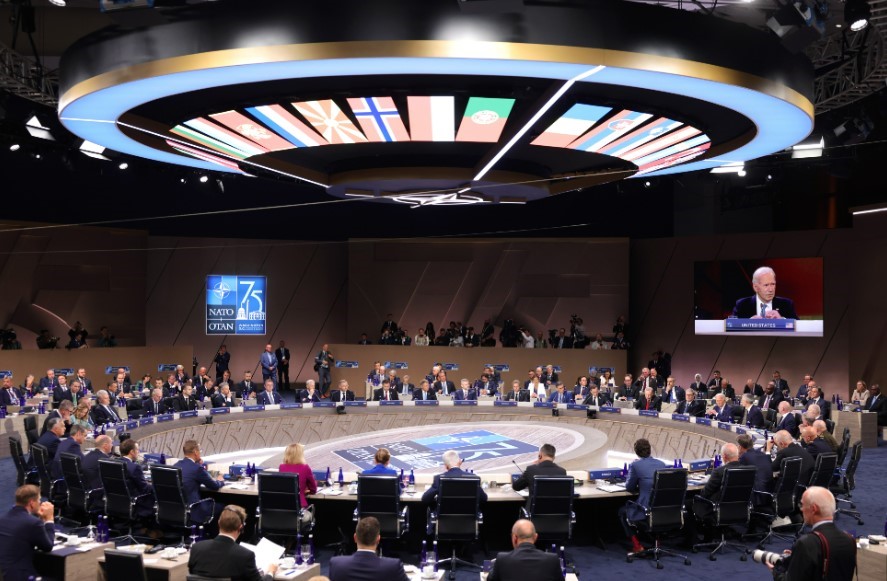
NATO Report Highlights Escalating Climate Risks to Global Security
Leaders from over 30 countries across North America and Europe convened in Washington last week for a NATO summit to discuss pressing security threats. During the summit, NATO issued a report emphasizing the increasingly severe dangers posed by climate change, framing it as a prominent adversary. As part of a comprehensive climate action strategy, the report examines how a spectrum of climate impacts—from heatwaves to ocean acidification—affects security infrastructure, military personnel, NATO's adversaries, and disaster response capabilities.
Human Impacts: NATO military personnel, often among the first responders to disasters, face heightened risks from climate extremes, according to the report. In 2023 alone, nearly 30 international military missions were deployed to manage climate-related emergencies in 14 countries, including Slovenia and Greece. Notably, over 600 U.S. military personnel were mobilized to combat the wildfires that devastated Hawaii, marking one of the largest responses to a single hazard in recent U.S. history. Soldiers regularly confront harsh conditions like dust storms, intense rain, and droughts, conditions expected to worsen as climate change intensifies. The report highlights an increase in "black flag weather days," necessitating operational limitations or halts in NATO regions due to temperatures exceeding 95 degrees Fahrenheit.
"Looking forward, Allied military forces must adapt to hotter temperatures and increasingly challenging, extreme, and unpredictable operational environments," the report states. It underscores the growing demand for military assistance during civilian disasters.
Impact on Infrastructure: Extreme weather events are wreaking havoc on NATO members' military equipment and infrastructure across all operational domains. On land, wildfires pose complex challenges; for instance, a July 2023 wildfire in Greece spread to an ammunition depot, triggering explosions. Arctic regions face dual threats from fires and thawing permafrost, destabilizing military bases like Alaska's Eielson Air Force Base and potentially exposing Cold War-era military waste sites in Alaska, Greenland, and Russia.
At sea, climate-induced changes in ocean chemistry may affect submarine operations' use of sonar, with some regions experiencing reduced detection ranges due to rising temperatures and ocean acidification. In the air, warmer temperatures are thinning the atmosphere, complicating naval helicopter operations and reducing cargo load capacities.
Virtual World Risks: The report also identifies emerging climate-related security risks in the virtual realm. Extreme weather events frequently disrupt crucial telecommunications networks used during disaster response efforts, exemplified by Hurricane Beryl's impact on Houston's energy infrastructure, knocking out power for nearly 3 million people. Additionally, cyber threats are rising, with extensive disinformation campaigns targeting climate initiatives. The report cites Russia as a prominent source of online misinformation surrounding the global shift to green energy.
NATO's Response to Climate Risks: At the recent summit, world leaders emphasized the urgency of addressing climate change to safeguard security. Canadian Prime Minister Justin Trudeau underscored that climate change risks creating a less stable, less prosperous, and less secure world. However, some experts criticize NATO's substantial carbon footprint from military activities, contributing to climate extremes it seeks to mitigate. NATO's "Climate and Security Action Plan," established in 2021, integrates climate considerations into political and military agendas, aiming to reduce emissions from military operations. Climate scenarios are now incorporated into NATO training exercises to prepare forces for operating in extreme conditions, with countries like the U.S. developing new, breathable combat uniforms to combat heat stress.
To mitigate infrastructure threats, efforts are underway to enhance base resilience against rising sea levels, flooding, and storm surges, including elevating piers and docks, improving drainage systems, fortifying buildings, and retrofitting critical infrastructure.
"The NATO climate impact assessment reveals that climate security threats not only affect vulnerable global regions but also pose significant risks to homeland security, prompting Allies to mobilize proactive measures," Bordoff remarked.
Additional Climate Highlights:
- Former President Donald Trump announced his running mate for the upcoming election, Republican Senator J.D. Vance from Ohio, despite his shift away from prior advocacy for climate action.
- Gray whales have been observed in unprecedented numbers in San Francisco Bay, a possible response to climate-driven shifts in food availability.
- Extreme heatwaves are leading to an increase in contact burns across the U.S., particularly affecting vulnerable populations.
- Seabirds in New York City are attacking drones deployed for coastal surveillance, highlighting challenges in integrating technology with wildlife conservation efforts.
- Farmers along the Eastern U.S. coast are exploring salt-tolerant crops as sea-level rise introduces saltwater intrusion into agricultural areas.